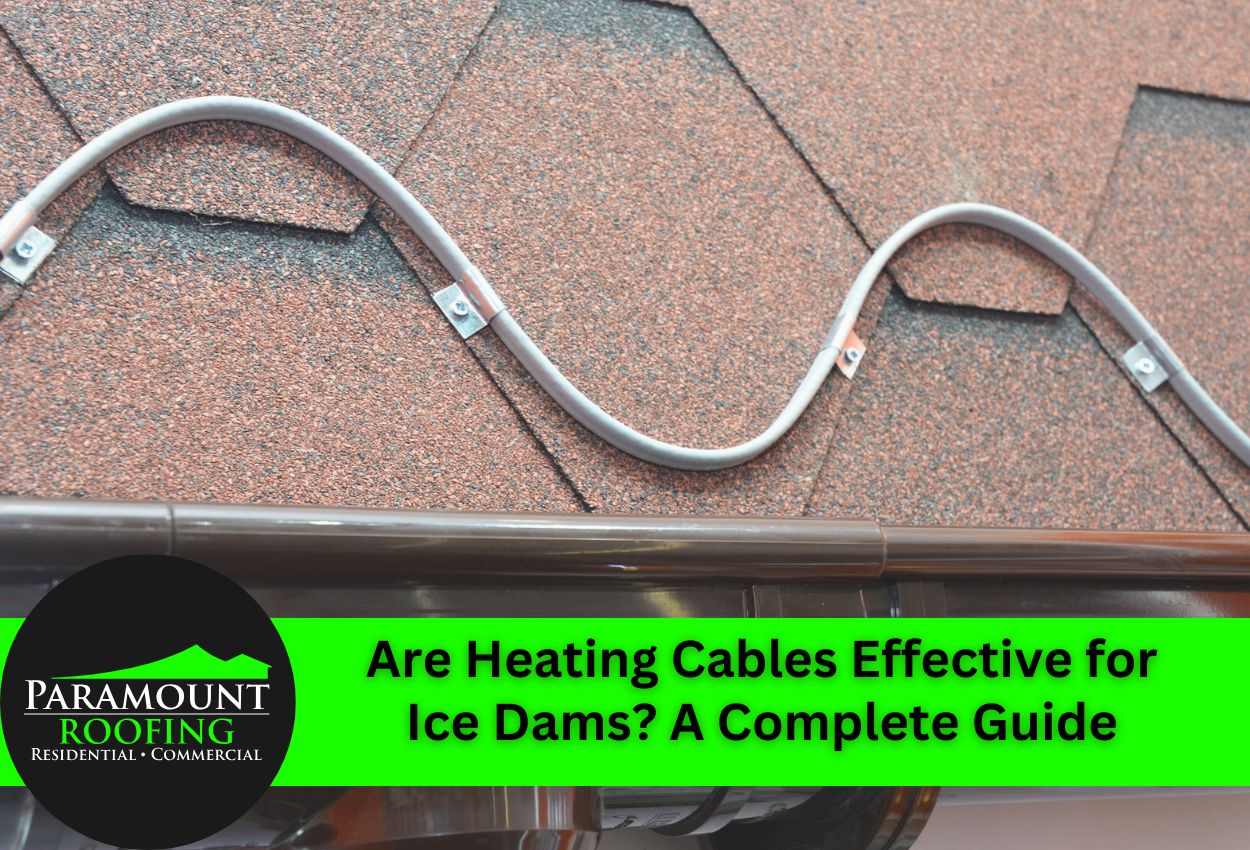Ice dams create serious problems for homeowners during winter. These thick ridges of ice are created along roof edges when snow melts and refreezes, blocking drainage and potentially causing water damage to homes. Detroit area residents know this challenge well, as heavy snowfall and fluctuating temperatures create perfect conditions for ice dams to form.
The formation process begins when heat from inside the home warms the roof surface, melting snow that then flows down toward the gutters. As this water reaches the colder roof edges, it freezes again, gradually building up barriers that trap additional melting snow. This trapped water can seep under shingles and cause expensive damage to ceilings, walls, and insulation.
Heating cables offer one potential solution for preventing ice dams in winter. These electric systems warm the roof edges and gutters to keep ice from forming dangerous blockages. Understanding how heat cables work on roofs helps homeowners evaluate whether this prevention method fits their specific situation.
Before investing in any ice dam prevention system, homeowners should look into their effectiveness, installation requirements, and alternatives to heat cables for ice dams. The best way to stop ice dams involves choosing the right approach for each home’s unique roof design and winter weather exposure.
How Heating Cables Work to Prevent Ice Formation
Answering the question, “How do heat cables work on roofs?” starts with their basic heating mechanism. Electric heating cables generate consistent warmth along roof edges and gutters through resistance heating. When electricity flows through the cable, it produces heat that maintains temperatures above freezing, creating clear pathways for melting snow and ice to flow safely off the roof structure.
This controlled heat can also melt accumulated snow and ice, allowing water to flow freely through gutters and downspouts instead of refreezing into dangerous ice dams. The cables maintain consistent temperatures even during extreme cold snaps, ensuring continuous drainage pathways throughout winter.
Different types of heating cable systems serve various roof configurations and installation needs. Self-regulating cables automatically adjust their heat output based on surrounding temperatures, making them an energy-efficient option for preventing ice dams in winter. Constant wattage cables provide uniform heat distribution along their entire length, ideal for gutters where consistent warming is essential.
Installation locations typically include roof edges, gutters, downspouts, and valleys where ice accumulation commonly occurs. Cables are strategically placed in zigzag patterns along roof edges and secured inside gutters to maximize coverage. Professional installation ensures proper placement and electrical connections for safe, effective operation throughout the winter season.
Real-World Effectiveness of Heating Cables Against Ice Dams
Heating cables are very effective for preventing ice dams in winter under specific weather conditions. These systems perform best during moderate snowfall with temperatures hovering between 15 and 32 degrees Fahrenheit. When snow accumulation remains manageable and temperatures allow for controlled melting, heating cables successfully maintain clear drainage pathways and prevent ice buildup along roof edges.
The cables prove most reliable when homeowners activate them before major snow events rather than after ice formation begins. Consistent operation throughout the winter months generally yields better results than intermittent use during storms. Roof heating cable installation also works particularly well on homes with moderate roof slopes where water flows naturally toward gutters without pooling in problem areas.
However, heating cables can face limitations during extreme weather conditions that challenge their effectiveness. Heavy snow exceeding 6 inches can overwhelm cable capacity, especially when combined with sustained sub-zero temperatures, while high winds that create uneven snow distribution may cause ice formation in areas beyond cable coverage zones.
Complex roof designs with multiple valleys, steep slopes, or inadequate attic insulation present additional challenges for heating cable systems and often require supplementary solutions beyond cable installation alone. Understanding the potential disadvantages helps homeowners set realistic expectations about heating cables and recognize when alternatives might provide better protection for their specific roofing situation.
Professional Installation vs. DIY Heating Cable Setup
Roof heating cable installation involves significant safety considerations that make contacting a professional recommended for most situations. Working on rooftops during winter conditions presents serious fall hazards, while electrical connections require understanding building codes and safety protocols. Licensed roofing contractors have the equipment and expertise to navigate icy surfaces safely while ensuring installations meet local electrical standards.
Technical requirements for heating cable systems extend beyond simple placement along roof edges. Proper installation requires an understanding of electrical load calculations, circuit protection requirements, and integration with existing home electrical systems. Professional installers know how to route cables through difficult areas like valleys and dormers while maintaining adequate clearances from other roofing components. They also understand spacing requirements that ensure even heat distribution without creating hot spots that could damage roofing materials.
Common DIY installation mistakes significantly reduce system effectiveness and create potential roof damage. Incorrect cable spacing often leaves gaps where ice can still form, while improper fastening methods may puncture roofing membranes and create leak points. Many homeowners underestimate the cable length needed for adequate coverage, resulting in incomplete protection zones where ice dams continue forming.
Another frequent error involves inadequate electrical connections that create fire hazards or system failures. DIY installations often lack proper weatherproofing of electrical components, leading to corrosion and premature system breakdown. Professional installation ensures proper integration with GFCI protection and appropriate circuit sizing for safe, reliable operation throughout the winter months.
Comparing Heating Cables to Other Ice Dam Prevention Methods
While heating cables can effectively prevent ice dams from forming, there are ways to reduce this risk in the first place. Roof insulation improvements and ventilation upgrades offer long-term solutions that address ice dam root causes rather than just managing symptoms. Sufficient attic insulation and ventilation reduce heat transfer that causes uneven roof temperatures and subsequent ice dams. These structural improvements typically provide more comprehensive protection than heating cables alone, especially during severe weather conditions.
Insulation upgrades are particularly effective for homes with insufficient attic coverage or outdated materials that allow excessive heat loss. Adding blown-in insulation or upgrading to modern materials creates thermal barriers that prevent the warming-cooling cycle responsible for ice formation. Ventilation improvements through ridge vents and soffit systems maintain proper air circulation that keeps the entire roof surface at consistent temperatures.
However, structural changes require large upfront investments and may not provide immediate results during ongoing winter seasons. Heating cables offer faster deployment when ice dam problems need immediate attention. These cables also work well as temporary solutions while homeowners plan larger insulation or ventilation projects for future seasons.
Combining multiple prevention strategies delivers maximum ice dam protection during harsh Michigan winters. Many roofing contractors recommend pairing heating cables with insulation improvements for comprehensive coverage to address both immediate protection needs and long-term prevention goals. Strategic placement of heating cables in problem areas, combined with proper attic insulation throughout the home, creates layered defense systems that perform reliably across varying weather conditions and roof configurations.
Long-Term Heating Cable Maintenance and Performance Expectations
Heating cable systems typically provide reliable ice dam prevention for up to 10 years with proper maintenance and care. The durability of these systems depends heavily on installation quality and regular upkeep throughout their operational life.
Homeowners should expect annual maintenance requirements that include visual inspection of cable routing and electrical connections before each winter. Checking for physical damage from debris, animals, or weather exposure helps identify problems before they compromise system effectiveness. Cable segments may require replacement if damaged sections develop breaks or exposed wiring that creates safety hazards.
Several warning signs indicate heating cables need repair or replacement to maintain their effectiveness in preventing ice dams in winter. Uneven melting patterns along roof edges suggest cable sections have failed or lost contact with surfaces. Ice formation in previously protected areas often signals that cables are no longer generating adequate heat in those zones.
Electrical issues become apparent when circuit breakers trip repeatedly or when cables fail to warm up during cold weather. Ground fault interruptions may indicate moisture infiltration into electrical connections that requires immediate attention. Homeowners should also watch for increased energy consumption without corresponding performance improvements, which often indicates aging cables operating less efficiently than newer systems.
Making the Best Decision for Your Home and Budget
Determining whether heating cables are a worthwhile investment requires considering several key factors specific to each home’s situation. The severity of existing ice dam problems plays a crucial role in this decision, as homes with recurring damage and repairs often benefit from cable installation more than properties with minor ice accumulation issues.
Roof design characteristics significantly influence heating cable effectiveness and installation complexity. Simple gable roofs with standard gutters typically see better results from cable systems than complex designs with multiple valleys, dormers, or irregular drainage patterns. Plus, homes with steep roof slopes may require extensive cable coverage to achieve adequate protection, increasing both installation and operational costs.
Energy consumption represents an ongoing expense that homeowners must factor into their decision. Heating cables consume electricity throughout winter, with usage varying based on weather conditions and system size. Properties with limited electrical capacity may require panel upgrades to accommodate cable systems safely, adding to the total investment required.
When consulting roofing contractors about heating cable installation, homeowners should ask specific questions about system sizing and coverage areas. Request detailed explanations of cable placement strategies for your particular roof configuration and drainage patterns. Ask about warranty coverage for both installation work and cable components, including what situations void warranty protection.
Contractors should provide clear information about expected energy consumption and operational costs throughout typical winter seasons. Understanding maintenance requirements and replacement schedules helps homeowners budget for long-term system ownership beyond the initial investment. By evaluating these factors, homeowners can make a final decision about installing heating cables, preventing ice dam issues, and protecting their property throughout Detroit’s harsh winters.
Discover How Paramount Roofing Can Protect Your Home This Winter
If you’re grappling with ice dam issues on your roof every winter, it’s time to consider a reliable solution that not only prevents damage but also protects your roofing structure. Heating cables might be the answer you’re looking for. These cables work by maintaining a clear path for the melted snow and ice to drain off the roof, preventing the buildup of ice that can lead to significant damage.
At Paramount Roofing, we specialize in protecting homes against the severe Michigan winters. With our expert services, you can reduce the risk of water damage and related repairs.
Call us today at (586) 690-0227 to learn more about how our solutions can meet your specific needs. Let Paramount Roofing help you make an informed decision that safeguards your home for years to come.
 Free Estimate
Free Estimate
 Request Service
Request Service Locations
Locations 
